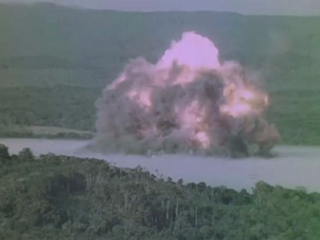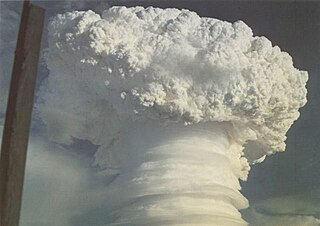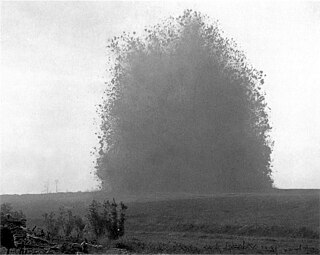
An explosive is a reactive substance that contains a great amount of potential energy that can produce an explosion if released suddenly, usually accompanied by the production of light, heat, sound, and pressure. An explosive charge is a measured quantity of explosive material, which may either be composed solely of one ingredient or be a mixture containing at least two substances.

Trinity was the code name of the first detonation of a nuclear weapon. It was conducted by the United States Army at 5:29 a.m. on July 16, 1945, as part of the Manhattan Project. The test was conducted in the Jornada del Muerto desert about 35 miles (56 km) southeast of Socorro, New Mexico, on what was then the Alamogordo Bombing and Gunnery Range, now part of White Sands Missile Range. The only structures originally in the vicinity were the McDonald Ranch House and its ancillary buildings, which scientists used as a laboratory for testing bomb components. A base camp was constructed, and there were 425 people present on the weekend of the test.

Project Plowshare was the overall United States program for the development of techniques to use nuclear explosives for peaceful construction purposes. The program was organized in June 1957 as part of the worldwide Atoms for Peace efforts. As part of the program, 35 nuclear warheads were detonated in 27 separate tests. A similar program was carried out in the Soviet Union under the name Nuclear Explosions for the National Economy.

Operation Crosstie was a series of 48 nuclear tests conducted by the United States in 1967–1968 at the Nevada Test Site. These tests followed the Operation Latchkey series and preceded the Operation Bowline series.

Operation Wigwam involved a single test of the Mark 90 "Betty" nuclear bomb. It was conducted between Operation Teapot and Project 56 on May 14, 1955, about 500 miles (800 km) southwest of San Diego, California. 6,800 personnel aboard 30 ships were involved in Wigwam. The purpose of Wigwam was to determine the vulnerability of submarines to deeply detonated nuclear weapons, and to evaluate the feasibility of using such weapons in a combat situation. The task force commander, Admiral John Sylvester, was embarked on the task force flagship USS Mount McKinley. Wigwam was the first atomic test in the deep ocean, and it remains the only test that has been conducted in water deeper than 1,000 ft (300 m).

Operation Blowdown was an explosives test carried out in the Kutini-Payamu jungle of Australia's Cape York Peninsula in 1963, to simulate the effects of a nuclear weapon on tropical rainforest. It was conducted by the Australian Army, the Department of Supply, and the Defence Standards Laboratory with participation from the United Kingdom, Canada and United States. In addition, blast effects on military material, field fortifications, supply points, and foot and vehicle movement were examined in a rain forest environment.

Operation Hardtack I was a series of 35 nuclear tests conducted by the United States from April 28 to August 18 in 1958 at the Pacific Proving Grounds. At the time of testing, the Operation Hardtack I test series included more nuclear detonations than the total of prior nuclear explosions in the Pacific Ocean. These tests followed the Project 58/58A series, which occurred from 1957 December 6 to 1958, March 14, and preceded the Operation Argus series, which took place in 1958 from August 27 to September 6.
Peaceful nuclear explosions (PNEs) are nuclear explosions conducted for non-military purposes. Proposed uses include excavation for the building of canals and harbours, electrical generation, the use of nuclear explosions to drive spacecraft, and as a form of wide-area fracking. PNEs were an area of some research from the late 1950s into the 1980s, primarily in the United States and Soviet Union.

There have been many extremely large explosions, accidental and intentional, caused by modern high explosives, boiling liquid expanding vapour explosions (BLEVEs), older explosives such as gunpowder, volatile petroleum-based fuels such as gasoline, and other chemical reactions. This list contains the largest known examples, sorted by date. An unambiguous ranking in order of severity is not possible; a 1994 study by historian Jay White of 130 large explosions suggested that they need to be ranked by an overall effect of power, quantity, radius, loss of life and property destruction, but concluded that such rankings are difficult to assess.

The explosive yield of a nuclear weapon is the amount of energy released such as blast, thermal, and nuclear radiation, when that particular nuclear weapon is detonated, usually expressed as a TNT equivalent (the standardized equivalent mass of trinitrotoluene which, if detonated, would produce the same energy discharge), either in kilotonnes (kt—thousands of tonnes of TNT), in megatonnes (Mt—millions of tonnes of TNT), or sometimes in terajoules (TJ). An explosive yield of one terajoule is equal to 0.239 kilotonnes of TNT. Because the accuracy of any measurement of the energy released by TNT has always been problematic, the conventional definition is that one kilotonne of TNT is held simply to be equivalent to 1012 calories.
An underwater explosion is a chemical or nuclear explosion that occurs under the surface of a body of water. While useful in anti-ship and submarine warfare, underwater bombs are not as effective against coastal facilities.
Terminal Ballistics Research Laboratory (TBRL) is a laboratory of the Defence Research and Development Organisation (DRDO) which comes under Ministry of Defence. Located in Chandigarh, the laboratory has become one of the major DRDO labs in the field of armament studies. TBRL is organized under the Armaments Directorate of DRDO. The present director of TBRL is Shri. Prateek Kishore.

Operation Sailor Hat was a series of explosives effects tests, conducted by the United States Navy Bureau of Ships under the sponsorship of the Defense Atomic Support Agency. The tests consisted of two underwater explosions at San Clemente Island, California in 1964 and three surface explosions at Kahoʻolawe, Hawaii in 1965. They were non-nuclear tests employing large quantities of conventional explosives to determine the effects of a nuclear weapon blast on naval vessels, and the first major test of this kind since Operation Crossroads in July 1946.
The United States's Sculpin nuclear test series was a group of 7 nuclear tests conducted between October 1990 and September 1991. These tests followed the Operation Aqueduct series and preceded the Operation Julin series.
The Voitenko compressor is a shaped charge adapted from its original purpose of piercing thick steel armour to the task of accelerating shock waves. It was proposed by Anatoly Emelyanovich Voitenko, a Soviet scientist, in 1964. It slightly resembles a wind tunnel.

Misty Picture was a test conducted on May 14, 1987 by the United States Defense Nuclear Agency involving the detonation of several thousand tons of conventional explosives to simulate the explosion of a small nuclear bomb.
The military research facility located 5 km (3.1 mi) north of Suffield, Alberta, operated under the name of the Suffield Experimental Station (SES) from 1950 to its renaming to the Defence Research Establishment Suffield in 1967.
Project 57 was an open-air nuclear test conducted by the United States at the Nellis Air Force Range in 1957, following Operation Redwing, and preceding Operation Plumbbob. The test area, also known as Area 13, was a 10 miles (16 km) by 16 miles (26 km) block of land abutting the northeast boundary of the Nevada National Security Site.

Operation Snowball was a conventional explosive test to obtain information on nuclear weapon detonations run by the Defence Research Board with participation from the United Kingdom and United States. A detonation of 500 short tons (454 t) of TNT was used to study the resulting phenomena. The test was held at the Suffield Experimental Station in Alberta and was the largest ever man-made, non-accidental explosion in Canada. The test was also the first of its kind using a stacked TNT block hemisphere of such magnitude, a method repeated in six subsequent tests such as Operation Sailor Hat and Prairie Flat. The test allowed verifying predicted properties of shock and blast and determining its effect on a variety of military targets at varied distances from ground zero.

Operation Prairie Flat was a test involving the detonation of a 500-short-ton (450 t) spherical surface charge of TNT to evaluate airblast, ground shock and thermal effects of nuclear weapons.














